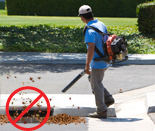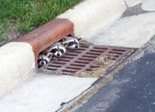 |
||

|
||
HomeWhat is stormwater runoff?Stormwater runoff results when rain falls on surfaces that cannot absorb it (like pavement or rooftops, or ground that is already saturated from rain) and flows overland toward stormwater inlets, swales, ditches, canals, lakes, wetlands, or coastal waters. Why is it a pollution problem?As stormwater runoff flows over land, it can pick up debris, chemicals, dirt, and other pollutants and carry these unwanted items into nearby waterways. Even if the runoff enters a stormwater system, much of it is discharged untreated into the waterbodies we use for swimming, fishing, and providing drinking water. Polluted stormwater runoff can have many adverse effects on plants, fish, animals, and people. Sediment can cloud the water and make it difficult or impossible for aquatic plants to grow. Sediment can also destroy aquatic habitats and harm organisms. Excess nutrients can cause algae blooms. When algae die, they decompose in a process that removes oxygen from the water. Fish and other aquatic organisms can't exist in water with dissolved oxygen levels that are too low. Bacteria and other pathogens can wash into swimming areas and create health hazards, often making beach closures necessary. What's it got to do with ME?Most of the unwanted pollutants that end up on our waterbodies come from human activities. We litter. We throw or dump things into storm drains. We fail to pick up after our pets. We over-fertilize and over-water. We blow or sweep leaves and grass clippings into the streets and/or swales. These activities, and many more, result in personal pollution that you can help prevent!!
|
Visitors to site: |
|
| A cooperative public education program of the Palm Beach County municipal stormwater systems group Website owned by NPBCID and maintained by Mock Roos | ||

 Yard waste does not belong in the stormwater system!
Yard waste does not belong in the stormwater system! Only stormwater belongs in a storm drain!
Only stormwater belongs in a storm drain!